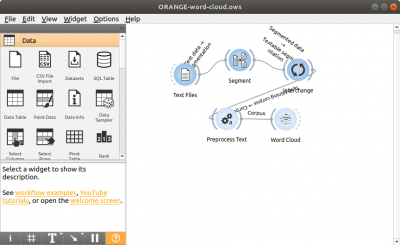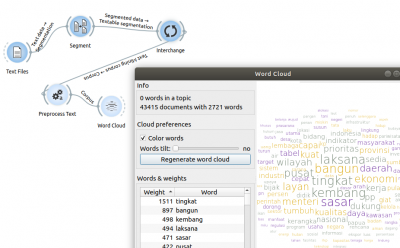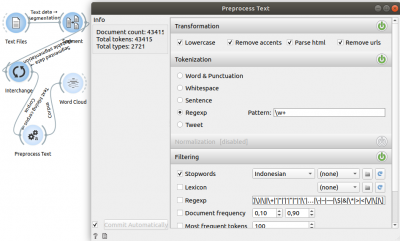Orange: Word Cloud dari File Text
Word Cloud data dapat di bangun dari file text (ASCII) yang kita miliki seperti pada workflow di bawah ini. Pertama-tama data dari Widget Text Files harus di segmented menjadi word menggunakan Widget Segment. Kemudian output segmented data perlu di konversikan dari segmented data menjadi corpus agar bisa di proses oleh toolbox text mining menggunakan Widget Interchange. Sebelum di tampilkan sebagai word cloud ada baiknya dilakukan preprocessing terlebih dulu, untuk mengurangi berbagai kata yang tidak dibutuhkan, seperti kata penghubungi dll menggunakan Widget Preprocess Text.
The workflow in Orange Data Mining shown in the image follows a text processing and visualization approach using a word cloud. Here’s the step-by-step breakdown:
1. Text Files (Loading Data)
- The Text Files widget is used to load text data from multiple files.
- These files contain textual information that will be analyzed.
2. Segment (Splitting Text into Segments)
- The Segment widget is used to split the text data into meaningful segments (e.g., sentences, paragraphs, or predefined sections).
- This step helps in structuring the data for further processing.
3. Preprocess Text (Cleaning and Normalization)
- The Preprocess Text widget processes the segmented text.
- Common preprocessing steps include:
- Tokenization (splitting text into words),
- Removing stopwords (common words like "the", "is", etc.),
- Stemming or lemmatization (reducing words to their base form).
- This prepares the text data for analysis.
4. Word Cloud (Visualizing Key Words)
- The Word Cloud widget generates a word cloud visualization.
- The most frequently occurring words appear larger, helping in identifying key terms and patterns in the dataset.
Summary
This Orange Data Mining workflow loads text files, segments the data, preprocesses the text for better readability, and visualizes the most frequent words using a word cloud. It is useful for text mining, exploratory text analysis, and keyword extraction.
The Orange Data Mining workflow in the image follows a text mining approach, processing large amounts of textual data and visualizing it through a Word Cloud. Here’s the breakdown:
Workflow Steps:
1. Text Files (Loading Data)
- The Text Files widget loads text data from multiple documents.
- The dataset contains 43,415 documents with 2,721 unique words.
2. Segment (Splitting Text into Meaningful Parts)
- The Segment widget splits the text into segments, such as sentences or paragraphs.
- This segmentation helps in structuring the text for further analysis.
3. Interchange (Managing Data Flow)
- The Interchange widget allows for interaction between different text*processing components.
- It ensures that segmented data is correctly passed to subsequent processing steps.
4. Preprocess Text (Cleaning and Normalization)
- The Preprocess Text widget processes the text by:
- Tokenizing (splitting text into words),
- Removing stopwords (common, less meaningful words),
- Stemming or Lemmatization (reducing words to their root forms).
- This step improves the clarity of data before visualization.
5. Word Cloud (Visualizing Important Words)
- The Word Cloud widget generates a visual representation of word frequency.
- More frequently occurring words appear larger, while less common words appear smaller.
Word Cloud Output in the Image:
- The Word Cloud visualizes frequently used words from the dataset.
- The top words in the dataset (along with their frequency) include:
- "tingkat" (1511 occurrences)
- "bangun" (897 occurrences)
- "kembang" (898 occurrences)
- "laksana" (494 occurrences)
- "sasar" (471 occurrences)
- The cloud is color-coded to improve readability.
Summary:
This Orange Data Mining workflow loads text documents, segments them, preprocesses the text, and generates a word cloud. The word cloud output provides insights into the most frequently used words, making it useful for text mining, keyword extraction, and trend analysis.
Pada Widget Preprocess Text kita dapat melakukan beberapa hal, seperti
- Mengubah agar semua huruf menjadi huruf kecil.
- Menghilangkan (stop word), kata-kata yang kurang bermanfaat seperti, kata penghubung seperti dan, di, ke, dari dll.
- Mengatur agar pemrosesan stopword dalam bahasa Indonesia.
- Menghilangkan tag HTML
- Menghilangkan URL
- dll.


